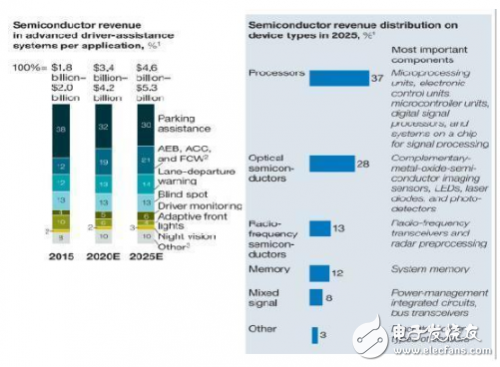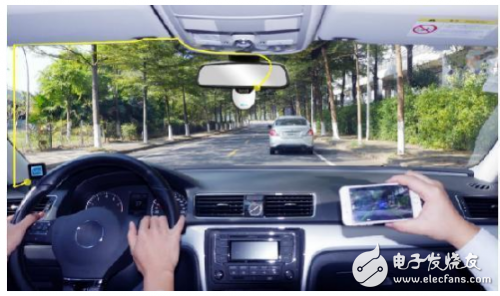This report has collected and analyzed the information resources of ADAS's future development trend, which provides valuable reference information for ADAS suppliers and investors. Vispect interprets the important information in this report and is willing to share it with peers. Explore.
First, the opportunity of semiconductor manufacturers in the ADAS industry, the camera program should become the mainMcKinsey & Company Original: We surveyed a large number of semiconductor manufacturers and analyzed their opportunities in the ADAS industry before 2025. Various factors were considered in the survey: including forecasting the adoption of the terminal market, system and component price decline.
The analysis concluded that the overall revenue of semiconductor manufacturers in the ades industry is expected to grow steadily, reaching approximately $4.6 billion to $5.3 billion in 2025. Sub-projection of total income:
1. For the system: "Parking Assistance System" is expected to bring the most revenue to semiconductor manufacturers. Followed by "automatic emergency braking", "adaptive cruise control" and "forward anti-collision warning (FCW)".
2. For system components: As shown in the figure below, “Semiconductor Manufacturers' Income Forecast Table in the ADAS Industry†shows that revenue growth is expected to be in processors (37% of total revenue) and sensors (28% of total revenue).

Figure: Semiconductor manufacturers' revenue breakdown in the ADAS industry
According to the experience of the adas industry, the processor-to-sensor cost ratio is about 1:1. From the above figure, “Semiconductor Manufacturers in the ADAS Industry Revenue Forecast Tableâ€, the manufacturer expects the future millimeter wave radar price range to be (double and single). The schemes are the lower and upper limits respectively:
The lower limit of the vispect calculation: the cost of the lens module x (13%/28%) = RMB100
The upper limit of the vispect calculation: the cost of the lens module is x13%/(37%-28%)=RMB350
For the case of the product, the product can be combined with the radar technology. The basis for cooperation or integration with the radar team is that after the radar process is stable and forms a formal industry, the price is greatly reduced. According to the current market situation and trend analysis, it is less feasible to reduce the price of millimeter wave radar to the lower price limit of RMB100/set.
Therefore, the vispect can be reversed: under the influence of the price factor, the possibility of implementation of the dual-inspection scheme is very low, and the camera solution will become the mainstream of the ADAS industry.
2. The general-purpose chip will become the mainstream, and the emerging ADAS team will win the new machine.McKinsey & Company's original text: It is expected that processors (37%) and sensors (28%) will account for the majority of semiconductor manufacturers' total revenue. Semiconductor manufacturers will consider entering the market segment through "differentiation", they can strengthen their systems and their products. Expand to "software" and "algorithms" to gain value.
As a result, vendors with industry experience in consumer electronics, mobile devices, or data processing can most effectively improve processor performance, and these performance enhancements will be the most important selling point. Since the fast processor is based on the technology of miniaturization, it requires a large investment in R&D and manufacturing. The sales revenue of the manufacturer in the auto market alone cannot fully satisfy the return on investment, and other sources of income are needed to obtain better. Return on investment.
In addition, manufacturers with adjacent industry experience can significantly adapt to adas applications by changing the performance of certain products into ADAS, which greatly shortens development time. For example, NVIDIA has been modified for game devices, smartphones and tablets. The Tegra platform was quickly used in automotive systems.
Interpretation: NVIDIA's route is compared with the original mobileye route, that is, the general-purpose chip is used in special industries and special industries to design their own dedicated chips. The former should become the mainstream. Based on this, it is speculated that mobileye is likely to be forced to transform the technical solution, and even lead to some problems; domestic Neusoft may get a lot of opportunities in the next two years. Vispect, good driving, Zhongtian Anchi, Yingying and other teams that have official products, the next step will be to increase market development efforts.

McKinsey's original text: In addition to the processor, sensor performance will also be greatly enhanced. There are many different types of sensors in the market today. For ADAS, the following three types of sensors are the most important:
One of the most cost-effective types of optical sensors is that optical sensors are generally based on camera solutions. This type of sensor is versatile and can perform a variety of adas functions, but they are susceptible to severe weather conditions and other environmental hazards. In addition to using the camera to collect image data of vehicles and pedestrians around the lane, it is also necessary to use complex software algorithms to process, identify and analyze the image.
The second type, the lidar system, uses laser scanning to generate 3D images of the surrounding environment. Unlike optical sensors, lidars are less sensitive to weather conditions and can directly detect the location of objects around the vehicle. Lidar has a large detection range and can reach around 100 meters around the vehicle, usually requiring external installation. In the past ten years, although the price has dropped from tens of thousands of dollars to several thousand dollars, the cost is still very expensive, and further price reduction is necessary for universal use. In addition, short-range Lidar systems can detect distances of up to 10 meters in a single direction. Such radars have been used in some vehicles, such as the Continental Group has provided short-range laser radar.
The third category, electromagnetic wave radar, determines the distance, velocity and direction of objects in short distances and distances. adas usually use 20 to 80 GHz. These sensors perform better than other sensors in adverse weather conditions, but the measurement range and angle are weaker. For example, electric wave radar can detect obstacles up to 250 meters. Because the measurement angle is quite narrow, adaptive cruise control usually combines electric wave radar with short-range laser radar to make a wide measurement angle.
Although the revenue generated by sensors (28% of total revenue) is lower than the processor (37% of total revenue), semiconductor manufacturers are more willing to invest and invest in the sensor field because it is easier to segment and size the enterprise. The requirements are not very strict. In fact, different sensors have different characteristics and are applied to adas products according to their different performance levels and signal processing capabilities. Like processors, semiconductor manufacturers can quickly gain an advantage if they have experience in neighboring industries. For example, semiconductor image sensors created for the consumer market can be quickly expanded to ADAS sensors to meet automotive safety requirements. It also meets the specific requirements of the car.
In addition, it is difficult for semiconductor manufacturers to enter the software field because they lack the advanced software technology foundation. In order to compete, they need to establish their own software team or merge and acquire external software teams.
In summary, semiconductor vendors integrate hardware, non-silicon products (including drivers, operating system adoption and codecs), algorithms (including software for real-time processing of sensor data), such as improved memory and central processing. Unit performance is improved, and this integration makes hardware enhancements that generate more value. In addition, semiconductor manufacturers will try to provide more modules or integrated solutions, such as system-on-chip SOC. ODM vendors tend to prefer single-component solutions, such as modules and integrated solutions (including software), because they provide better performance, lower development costs, and lower reliance on Tier 1 suppliers.

This part of the content implies that the liquidation ability of the future "algorithm" itself is likely to drop drastically and become the standard library that comes with the chip. Once the "algorithm" of the application level is mature, the diffusion will be very fast, and its value will show a cliff-like drop; the "algorithm" of the low-frequency special application still has its own living space. At present, some chips or ADAS module suppliers have provided functions, which are almost free, but the test results are different. For example, the M1 module of vitro uses the latest "algorithm" developed by itself, and the consistency rate is very high when the target mobileye is targeted; The module differs greatly from mobileye in the benchmarking process.
The word "algorithm" itself is an inaccurate wording, and the correct term is application software. The algorithm-specific exponential method, its basic method has been formed in the 18th century, and the application methods in various CV fields are the achievements of the mathematics community, shared by all human beings, and no one can and may monopolize.
In the process of ADAS productization, in the practice of constantly adjusting various parameters, choose various methods, the essence is an engineering problem, is the "money can solve the problem", especially in recent years with the introduction of various AI tools, development and change It's faster, even a large number of developers no longer need to have a strong mathematical foundation, because the mathematics part has been solved by the group of "development and development tools", and the results are provided to the development of ADAS software in a nearly free way. By.
There is a rule, custom laptop is called programming laptop cause nearly 90% is used for projects. 15.6 inch laptop for coding and programming is usually equipped with 10th or 11th cpu, 2gb or 4gb graphics optional. 15 inch laptop untuk programming is used on big tender or group for a special jobs. 15.6 inch programming laptop under 30000 is a more competitive one for business or high school students or teachers.
However, here is the recommended laptop for programming, especially for heavy office jobs or university coursework, since double heat-releasing, metal body, bigger battery, FHD screen, high-level cpu, etc. Build the deep and stable foundation to enjoy smooth running experience. Your clients will satisfy it`s excellent performance. Of course, there are other lower specification with tight budget.
As a entry windows laptop for programming, this 14 inch celeron Education Laptop is the most competitive and hottest device for elementary project.
Any other special requirements, just contact us freely.
Programming Laptop,Laptop For Coding And Programming,Programming Laptop Under 30000,Recommended Laptop For Programming,Windows Laptop For Programming
Henan Shuyi Electronics Co., Ltd. , https://www.shuyicustomlaptop.com